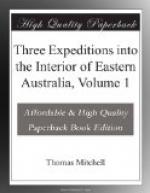SOLITARY CREEK.
The road reaches at three miles from the Cox a small brook, named Solitary Creek, which waters a valley where an inn was then building. This is the first rivulet falling towards the interior country, all the other streams previously crossed by this road flowing to the eastern coast; consequently the apparently low ridge between Solitary creek and Cox’s river is there part of what is termed the Coast Range, which extends from Cape Howe to Cape York, across 33 degrees of latitude.
HONEYSUCKLE HILL.
The road beyond Solitary creek winds around the side of Honeysuckle Hill, a summit of considerable elevation, consisting of trap-rock. The country beyond that hill is more open and favourable for road-making. An inn has been built on a small flat, distant about twenty-three miles from Mount Victoria, and about halfway between that pass and Bathurst.
STONY RANGE.
The only remarkable feature on the remainder of this line is Stony Range, distant from Bathurst fourteen miles. It is a ridge of high ground which traverses the country from north to south and terminates on the Fish river. The road crosses it at the very lowest part, and where the rock consists of a dark grey felspar with grains of quartz. The soil is red and rich, and bears trees of uncommon magnitude. The timber is found useful by the inhabitants of the Bathurst district, who keep the sawyers constantly at work there.
PLAINS OF BATHURST.
From Stony Range the plains of Bathurst appear in the distance to great advantage; the eye of the traveller from Sydney having long sought, in vain, for some relief from the prospect of so much waste mountainous country.
THE TOWN.
We reached the open plains of Bathurst, six miles from the settlement. I arrived early at Mrs. Dillon’s inn, where I took up my quarters, in order that I might complete, with less interruption, a report which I was instructed to make to the Governor from this place, respecting the state of the works along the road.
April 3.
My friend Rankin called and insisted on my accompanying him to his residence at Saltram, which I accordingly did. The houses of the inhabitants here are scattered over the extensive open country, and give a most cheerful appearance to the plains of Bathurst. These fine downs only a few years before must have been as desolate as those of a similar character still are on the banks of the Namoi and Karaula. Peace and plenty now smile on the banks of Wambool,* and British enterprise and industry may produce in time a similar change on the desolate banks of the Namoi, Gwydir, and Karaula, and throughout those extensive regions behind the Coast range, still further northward—all as yet unpeopled, save by the wandering aborigines, who may then, as at Bathurst now, enjoy that security and protection to which they have so just a claim.
(Footnote. Native name for the river Macquarie.)




